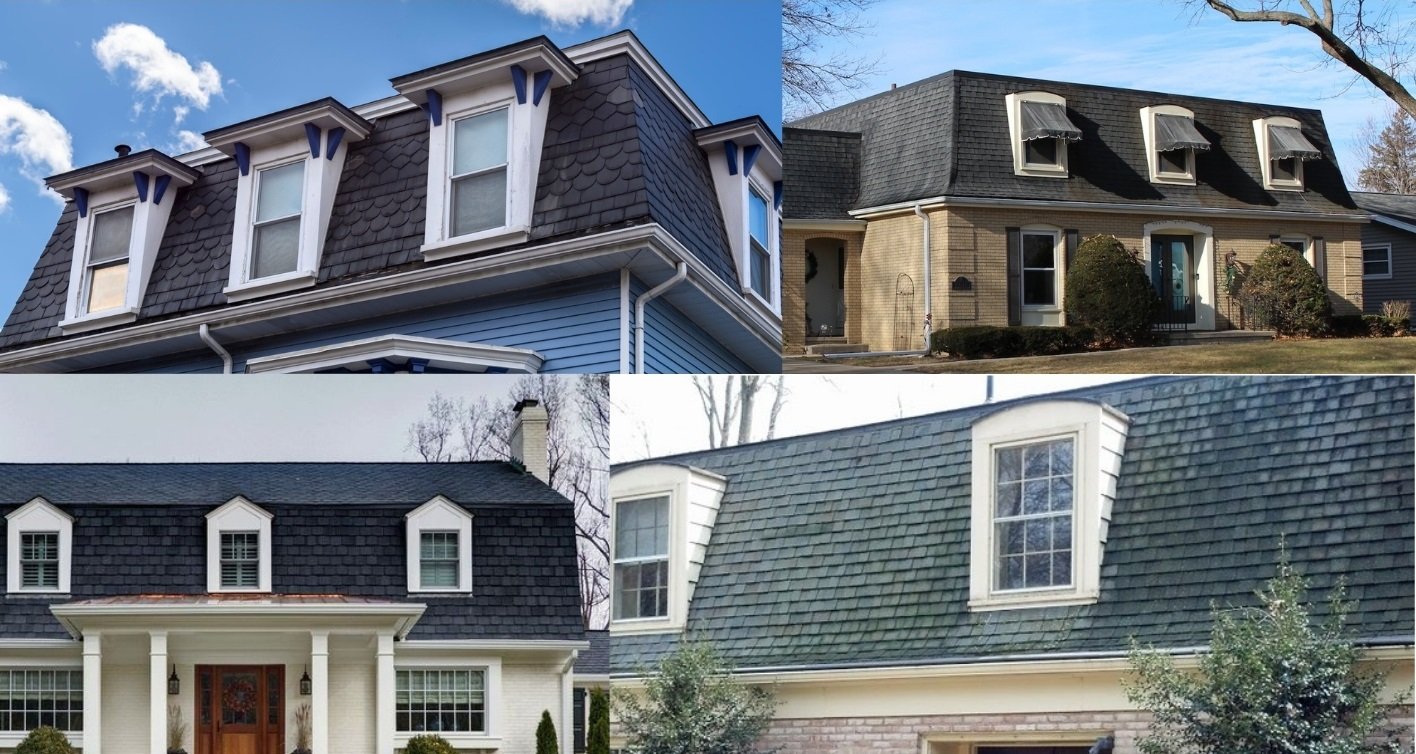Introduction
When it comes to roofing, one of the most distinctive and versatile designs is the mansard roof. Originating from French architecture, this roof style has been a favorite for centuries due to its aesthetic appeal and practical benefits. In this comprehensive guide, we will explore everything you need to know about mansard roofs, including their history, design elements, benefits, and installation considerations. Understanding the intricacies of mansard roofs can help homeowners and contractors make informed decisions about incorporating this unique style into their projects.
What is a Mansard Roof?
A mansard roof, also known as a French roof or curb roof, is a four-sided gambrel-style hip roof characterized by two slopes on each of its sides. The lower slope is significantly steeper than the upper slope, which may be almost flat. This design creates a spacious attic or living space under the roof, making it a popular choice for homes and buildings where maximizing space is a priority.
The mansard roof is not only functional but also offers a unique aesthetic that can enhance the architectural beauty of any structure. Its distinctive shape can give a building a more grand and sophisticated appearance. Additionally, the mansard roof allows for greater flexibility in interior design, as the added space under the roof can be utilized in various ways.
History of Mansard Roofs
The mansard roof is named after the French architect François Mansart, who popularized the design in the 17th century. Mansart’s innovative use of this roofing style became a hallmark of French Renaissance architecture. The design gained further prominence during the Second Empire period in France, particularly under the reign of Napoleon III. Mansard roofs were commonly used in Parisian buildings, adding an elegant and grand appearance to the city’s skyline.
The historical significance of the mansard roof extends beyond France. It became a popular architectural feature in other parts of Europe and North America, particularly during the Victorian era. Many historic buildings with mansard roofs are now considered architectural treasures, reflecting the craftsmanship and design principles of their time. Today, the mansard roof continues to be appreciated for its historical charm and timeless elegance.
Design Elements of Mansard Roofs
Mansard roofs are distinguished by several key design elements.
- Double Slopes. The primary feature of a mansard roof is its double-sloped design. The lower slope is steep and may contain dormer windows, while the upper slope is more gradual. This design maximizes the usable space within the roof area, making it ideal for creating additional rooms or storage spaces.
- Dormer Windows. The primary feature of a mansard roof is its double-sloped design. The lower slope is steep and may contain dormer windows, while the upper slope is more gradual. This design maximizes the usable space within the roof area, making it ideal for creating additional rooms or storage spaces.
- Eaves. The overhanging eaves of a mansard roof protect the exterior walls from rain and snow, contributing to the roof’s durability. Eaves can also be adorned with decorative trim or molding, enhancing the visual appeal of the roof and the overall building.
- Materials. Mansard roofs can be constructed using various materials, including slate, wood shingles, metal, and asphalt shingles. The choice of materials can impact the roof’s appearance, cost, and longevity. Slate and wood shingles, for example, offer a classic and upscale look, while metal and asphalt shingles provide more affordable and low-maintenance options.
Benefits of Mansard Roofs
Mansard roofs offer several advantages that make them an attractive option for homeowners and builders.
- Increased Living Space. The steep lower slope creates additional living space under the roof, which can be used for bedrooms, offices, or recreational areas. This added space can significantly increase the functionality and value of a home.
- Aesthetic Appeal. The unique design of a mansard roof adds a touch of elegance and sophistication to any building. It is particularly well-suited for historic and upscale homes, enhancing their architectural character and curb appeal.
- Versatility. Mansard roofs can be adapted to various architectural styles, from traditional to modern. This versatility makes them a popular choice for both residential and commercial buildings, allowing for creative and customized design solutions.
- Enhanced Natural Light. Dormer windows on the lower slope allow natural light to flood the attic or upper living space, reducing the need for artificial lighting. This can create a bright and inviting environment while also helping to lower energy costs.
- Weather Protection. The overhanging eaves and steep lower slope provide excellent protection against rain, snow, and wind, helping to extend the lifespan of the roof. Properly installed mansard roofs can withstand harsh weather conditions and maintain their structural integrity over time.
Considerations for Installing a Mansard Roof
While mansard roofs offer numerous benefits, there are also several factors to consider before installation.
- Cost. Mansard roofs can be more expensive to install than traditional roofs due to their complex design and the need for additional materials. However, the increased living space and aesthetic appeal can offset the initial investment, making it a worthwhile consideration for many homeowners.
- Maintenance. The intricate design of a mansard roof may require more maintenance than simpler roof styles. Regular inspections and upkeep are essential to prevent issues such as leaks and damage to the dormer windows. Homeowners should be prepared for the ongoing maintenance needs associated with mansard roofs.
- Building Codes. Before installing a mansard roof, it is important to check local building codes and regulations. Some areas may have restrictions on roof height and design, which could impact the feasibility of a mansard roof. Working with a knowledgeable contractor can help ensure compliance with all relevant codes and standards.
- Structural Support. The added weight of a mansard roof may require additional structural support. It is crucial to work with a qualified architect or engineer to ensure that the building can safely support the roof. Proper structural planning and reinforcement are key to the successful installation of a mansard roof.
Mansard Roof Design Variations
Mansard roofs come in several design variations, each with its own unique characteristics.
- Straight Mansard Roof. This design features a uniform slope on all four sides, creating a clean and symmetrical appearance. It is often used in classical and formal architectural styles, providing a balanced and harmonious look.
- Convex Mansard Roof. The lower slope curves outward, creating a more rounded and elegant profile. This design adds a touch of sophistication and can make a building appear more stately and impressive.
- Concave Mansard Roof. The lower slope curves inward, giving the roof a distinctive and dramatic look. This variation is less common but can create a striking and memorable architectural feature.
- Flared Mansard Roof. The lower slope flares out at the bottom, providing additional eave coverage and a more pronounced appearance. This design can enhance the roof’s functionality by offering greater protection to the exterior walls and creating a more dynamic visual effect.
Examples of Mansard Roof Houses
Mansard roofs can be found in various architectural styles and building types, including.
- French Country Homes. Mansard roofs are a defining feature of French country homes, adding charm and character to these rustic yet elegant residences. The combination of the mansard roof with traditional stone or stucco facades creates a timeless and inviting appearance.
- Victorian Houses. Many Victorian-era homes feature mansard roofs, often adorned with ornate details and decorative trim. These roofs contribute to the intricate and elaborate design that is characteristic of Victorian architecture, making each home a unique work of art.
- Modern Mansard Homes. Contemporary architects have embraced the mansard roof for its versatility and ability to create unique, modern designs. By incorporating clean lines and innovative materials, modern mansard homes offer a fresh and stylish take on this classic roofing style.
- Commercial Buildings. Mansard roofs are also used in commercial architecture, providing a sophisticated and professional appearance for office buildings, hotels, and retail spaces. The additional space created by the roof can be used for penthouse suites, conference rooms, or other functional areas.
How to Maintain a Mansard Roof
Proper maintenance is essential to ensure the longevity and performance of a mansard roof. Here are some tips for maintaining this type of roof.
- Regular Inspections. Conduct regular inspections to check for signs of damage, such as cracked shingles, leaks, or damaged dormer windows. Identifying and addressing issues early can prevent more extensive and costly repairs.
- Cleaning. Keep the roof clean by removing debris, leaves, and moss that can accumulate and cause damage over time. Regular cleaning helps maintain the roof’s appearance and prevents the buildup of materials that can trap moisture.
- Repairs. Address any issues promptly to prevent further damage. This includes fixing leaks, replacing damaged shingles, and repairing or replacing damaged dormer windows. Timely repairs can extend the lifespan of the roof and ensure its continued performance.
- Gutter Maintenance. Ensure that gutters and downspouts are clean and functioning properly to prevent water from backing up and causing damage to the roof and eaves. Proper drainage is crucial for protecting the roof and the structure of the building.
- Professional Maintenance. Consider hiring a professional roofing contractor to perform regular maintenance and inspections. They can identify and address potential issues before they become major problems, providing peace of mind and ensuring the roof remains in optimal condition.
The Role of Mansard Roofs in Energy Efficiency
Mansard roofs can contribute to a building’s energy efficiency in several ways.
- Insulation. The additional living space created by the steep lower slope can be insulated to improve thermal efficiency and reduce heating and cooling costs.
- Natural Ventilation. Dormer windows can be used to enhance natural ventilation, reduce the need for air conditioning, and improve indoor air quality.
- Reflective Materials. Using reflective roofing materials can help reduce heat absorption, keep the building cooler in the summer, and reduce energy consumption.
- Solar Panels. The flat upper slope of a mansard roof is ideal for installing solar panels, providing a renewable energy source and further reducing energy costs.
Mansard Roofs and Historical Preservation
Mansard roofs are often associated with historical buildings and architectural preservation efforts. Here are some ways mansard roofs play a role in preserving architectural heritage.
- Restoration Projects. Many historical buildings with mansard roofs undergo restoration to preserve their original design and character. This often involves repairing or replacing damaged roofing materials and restoring decorative elements.
- Architectural Significance. Mansard roofs are an important feature of many historic buildings, contributing to their architectural significance and cultural heritage. Preserving these roofs helps maintain the historical integrity of the building and its surroundings.
- Adaptive Reuse. Mansard roofs can be incorporated into adaptive reuse projects, where historical buildings are repurposed for modern use while preserving their original architectural features.
Conclusion
Mansard roofs are a timeless and versatile roofing style that offers numerous benefits, from increased living space and aesthetic appeal to enhanced energy efficiency and historic preservation. Understanding the design elements, benefits, and considerations for installing and maintaining a mansard roof can help homeowners and contractors make informed decisions about incorporating this unique roof style into their projects. Whether you are restoring a historic building or designing a modern home, a mansard roof can add elegance, functionality, and value to your property.
For more information on roofing and related services, visit Pro24 Contracting and explore our comprehensive roofing solutions tailored to meet your specific needs.

